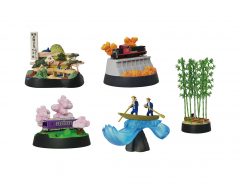- Source:
- © JAPAN Forward / © Jotaro Saito
- Tags:
- Fashion / fashion designer / innovation / JAPAN Forward / Jotaro Saito / Kimono / Kyoto
Related Article
-

[Kimono Style] Kyoto Jidai Matsuri: A Catwalk of Fashion Through the Ages
-

Interview with Masaaki Shiozawa: The “Founding Father” of Maid Clothes
-

Increase Your Catch Rate With These Classy Pokémon Glasses
-

Heart of Everyday Life: British Pub vs Japanese Izakaya
-

Now You Can Experience Traditional Japanese Art in Mixed Reality at Historic Kyoto Temple[PR]
-

Miniature landscapes capture the quintessence of memorable Arashiyama, Kyoto



(by Arielle Busetto for JAPAN Forward)
Jotaro Saito doesn’t go unnoticed when walking down a street. The day I met him at Kanda Myojin, he was sporting a flashy patterned kimono, which might well have caused passersby to do a double take: an elegant jeans fabric in a beautiful black and white pattern.
For foreign visitors, the common perception of Japanese kimono experience seems to be kimono rentals. More adventurous visitors might buy a yukata, the lighter summer kimono, but it often stops there.
Japanese themselves often have kimonos passed down in their family, but they might have little chance to wear one.
In this context, Jotaro Saito is breaking conventions to bring back the kimono as fashion for today’s world. At JAPAN Forward we sat down with this designer to hear how he started out.
Three Generations of Kimono Designers
It doesn’t come as a surprise somehow to find out that this designer — bursting with creativity — comes from Kyoto. He even joked with us: “Kyoto is always bursting with ideas. To some extent, Tokyo can be more conservative.”
Saito explains how he comes from a family of kimono dyers in which each generation sought to innovate further and bring something new to the industry.
“I suppose I come from a family of innovators. It was my grandfather who first put his name to the brand. Then, my father was the first one to propose the kimono as a holistic design. Before, you would sell either the obi or the kimono fabric, but he proposed coordinating both together.”
Then came Jotaro Saito, who broke convention from the start by having his debut at the young age of 27. He explained the idea behind his contribution. “To meet the new age, I wanted to make a kimono which wasn’t old, but was cool, new, and something which everyone wanted to wear.”
© JAPAN Forward
Nothing New Comes Easy
As many designers are aware, not all roads to success come in a straight line. Jotaro Saito’s experience is no different.
“Traditionally, in the kimono business, if you are making kimonos you are not supposed to sell directly to the consumer. But with the new age of the internet, shopping was changing. So I realized that we had to change the way we marketed to reach the end user,” he said.
Then came a big break. The Mori Building, where the shop was opened in 2011, was interested in featuring Saito’s vision of a new way of designing kimonos.
It was through the Mori Building connection that Jotaro Saito came to open his new shop in the brand new and glossy GINZA SIX complex, smack in the middle of what is commonly known as Tokyo’s most elegant shopping district.
© JAPAN Forward
Saito has participated in Mercedes-Benz Fashion Week since 2006, the ultimate sign of his intention to have his designs seen as fashion for today. However, he admits, even that hasn’t always been such smooth sailing.
© JAPAN Forward
“It’s tricky because the kimono, for example, doesn’t have its own section in fashion magazines. It’s not as much in the media. So when the fashion show would come and the selection process would start, inevitably there would be the debate, ‘Is the kimono even fashion?’”
© JAPAN Forward
Jotaro Saito told us he didn’t lose faith, however. And in recent years the debate has been changing.
“For example, especially during Amazon Fashion Week, you have young designers from Cambodia who present designs which, like Ao Dai (the Vietnamese traditional dress), also are not well-accepted. But surely that’s fashion, isn’t it? So, one step at a time, I think the kimono is starting to be recognized as fashion.”
Written by Japan ForwardThe continuation of this article can be read on the "Japan Forward" site.
Kimono Fashion Can Be Cool — Trust Designer Jotaro Saito